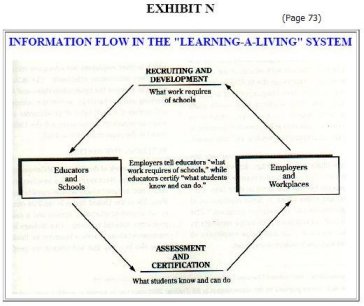Labor - Background
In 1990, under the leadership of Elizabeth Dole, Secretary of Labor, a project was initiated to define “What Work Requires of Schools” and to provide the leadership in transforming the schools to meet those requirements. The name of the project was the Secretary’s Commission on Achieving Necessary Skills (SCANS). The first step in this process was to standardize job descriptions and to define the skills and qualities (specifications) for any given job. This standardization was necessary for data collection so that the “employability skills” of American students and workers could be assessed and the curriculum changed to meet the requirements of business.
In April of 1992, the SCANS Commission released a report titled, “Learning A Living: A Blueprint for High Performance” that presented the plan to radically change the U.S. system of public education to serve the interests of business. The focus moved from academic learning to those basic skills that employers defined as requirements and it specified that “workplace learning” should begin in kindergarten and should be incorporated in the lessons in every class in the curriculum throughout K-121.
Between 1992 and 1998 a series of bills were enacted to effectively merge the State Employment offices with the Education Departments and with the merger, a change in mission to “workforce development” for both departments. This merger was a major step towards the “seamless web” of cradle-to-grave, national ‘Human Resource Management”.
1992 Job Training 2000 Initiative
1994 School-To-Work Opportunities Act
1994 National Skill Standards Act of 1994
1994 Goals 2000: Educate America Act
In 1998 with the preliminary enabling legislation in place, the Workforce Investment Act (WIA) of 1998 was passed to formalize the merger and to make the Workforce Development Councils - guided by appointed “stakeholders” the driver in the transformation of education to worker training. The 1999 U.S. Conference of Mayors had this to say about the WIA2:
§
One Stop Centers
integrate the
services of a number of government
funded programs — no longer requiring employers or job
seekers to go
“door-to-door” to obtain services.
§
Local Workforce
Investment Boards,
appointed by the chief elected
official, are the central planning authority for workforce
investment funds.
Under this new law, the federal government has greatly diminished its role and
given wide latitude to local communities. Mayors will now be able to leverage
workforce investment policy in concert with their economic development
agenda — enriching their human capital infrastructure and strengthening the
ability to meet the ever increasing needs of employers for a skilled workforce
The plan for the Workforce Investment Boards to be the central planning authorities was repeated in another Marc Tucker report under the auspices of the ‘New Commission on Skills of the American Workforce’ presented in January of 2007 titled, “Tough Choices or Tough Times” on page 19:
Step 10: Create Regional Competitiveness Authorities….. So the Commission recommends that the federal government develop legislation to encourage the states to create regional economic development authorities involving the key leaders from many sectors in those regions in the development of economic development strategies that make sense to them. These authorities would not only be responsible for coming up with development goals and strategies for their regions, but also for coordinating the work of the region’s education and training institutions to make sure that each region’s workers develop the skills and knowledge needed to be successful in that labor market.
We settled on the word “authorities” to describe these new bodies because we wanted to convey the idea that they need to be more than debating societies. They need to be able to raise and spend the money needed to develop their regions over time. If these new bodies are as successful as we think they will be, the federal government should consider lifting many of the restrictions on the separate programs they will administer and permitting them to combine the funds from these programs in ways that are more likely to lead to both strong economic growth and strong job growth, especially for the most vulnerable people in the country.
And it was repeated again by John Engler, CEO of the National Manufacturers Association (NAM) at a press conference on NAM’s 2007 agenda. John Engler is also a member of the National Skills Commission. At press conference, Engler spoke about his work with the Skills Commission. An audio clip was captured and can be heard by clicking HERE.
The merger of the state Workforce Development Departments and the Education system includes the integration of the computer systems. In previous research on the Idaho Workforce Development Council a few years ago, it was discovered that the same person was Chairwoman on both the WD Council and the Idaho State Board of Education, Assessment and Accountability and that she was overseeing the implementation of the SCANS computer coding systems for workplace skills into the school computer system. Looking back at the SCANS Blueprint that was produced in 1992, on page 61, it says the following:
Educational Testing Service. ETS is developing WORKLINK, an electronic information system linking local schools and employers. WORKLINK is an “employer friendly” record to make school performance count in the workplace. It provides employers (1) a reformatted high school transcript that is easy to interpret; (2) work-skills assessment covering such aptitudes as reading and using manuals, everyday math, and writing skills; (3) information on job-related behavior, including punctuality, timely work completion, and willingness to follow directions; and (4) information on work experience and out-of-school training. Students will be able to use their records as a resume, and employers will be able to locate potential employees from a computerized WORKLINK database managed locally.
On page 73 of the SCANS Blueprint, there is a diagram of the ‘feedback loop’ between schools and employers. This diagram plus the above paragraph tells us that the intent is to use the integrated school/workforce development systems as a permanent record of a person’s education and work history or as Marc Tucker described it, “a seamless web, cradle-to-grave” human resources system.
During the Clinton Administration, Al Gore busied himself “reinventing government”. As a part of that project, he picked up the SCANS project. One of the initiatives he oversaw was “America’s Talent Bank”. America’s Talent Bank is the networked databases of state education/workforce systems. The other piece of the system was named America’s Job Bank. It's still there but they are shutting it down - again moving the system behind a facade of "private interests". Notice "Private Portals".
Free Trade in Human Commodities
The webpages from the original America's job bank have been captured HERE in a pdf along with other pages showing the transition. The above graphic image was captured from page 7. It provides the forward and backward linkage of this system - specifically, the two people are standing on a web (seamless web), there is a globe in the background, the two people are representative what might appear to be an employer and employee, but in a ‘free market’ world, they would be a buyer and seller of labor.
1 Department of Labor, “Learning a Living: Blueprint for High Performance”, p93 http://www.channelingreality.com/UN/Documents/Learning%20A%20Living.pdf
2 U.S. Conference of Mayors, 1999, “Enhancing the Economic Growth of Cities: A Guidebook for Mayors on Leveraging the Workforce Investment Act of 1998”, p6 http://www.channelingreality.com/UN/Education/Workforce_Investment.pdf

